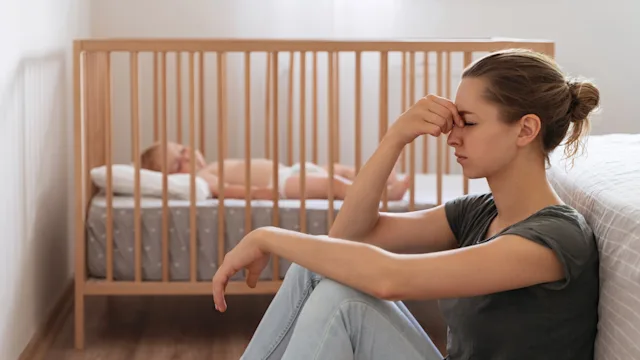Key takeaways:
Postpartum depression is common, but it affects people differently. The symptoms and how long they last can vary from person to person.
Symptoms typically appear within weeks to months after giving birth and can last for months to years.
Early diagnosis and treatment may help shorten the duration of postpartum depression.
Bringing a child into the world can be a joyous time in a woman’s life. But life after pregnancy is challenging. Caring for a newborn and yourself after this major event takes a toll on both the body and mind.
It’s normal to experience sadness and worry within the first 2 weeks after having a baby, and this is often called the “baby blues.” But when these feelings last longer, that may be a sign of postpartum depression (PPD). This is a common condition that affects as many as 1 out of every 8 women, and that rate has risen over the past several years.
Let’s review the symptoms of PPD, who’s at risk, and how long PPD lasts.
Search and compare options
Quiz: Do I have postpartum depression?
How long does postpartum depression last?
The timing of when postpartum depression appears and how long it lasts is different from person to person. Most mothers experience symptoms within the first few weeks of giving birth (often within 6 weeks). But some people don’t develop PPD symptoms until after 6 months.
Women with PPD can experience symptoms for months or longer. In fact, studies have found that PDD can even last up to 3 years after birth.
Certain factors can increase the risk of persistent PPD symptoms:
Younger age
Giving birth more than once
Early delivery
Gestational diabetes
Women who have severe symptoms for months without receiving treatment may also be at higher risk of experiencing PPD symptoms for a longer period. For this reason, don’t put off talking with a healthcare professional so that you can get the help and treatment you need as early as possible. Remember that not everyone will experience symptoms that are long-lasting , and there are things you can do to help yourself.
Signs and symptoms of postpartum depression
Women experience a wide range of feelings during the first few weeks after birth, so it might be hard to tell if these feelings are due to life change, pure sleep exhaustion, or a sign of something more serious.
Symptoms of PPD include:
Overwhelming sadness
Excessive crying
Feeling distanced from loved ones
Anger and mood changes
Difficulty concentrating
Problems with memory
Feelings of guilt
Thoughts of hurting yourself
Difficulty bonding with your baby or thoughts of hurting your baby
How long does postpartum depression last? Three moms share their journey with postpartum depression and how they got better.
Feeling anxious after childbirth? Learn more about postpartum anxiety and when you should get help.
Can men get postpartum depression? Yes, here’s what symptoms can look like in fathers after childbirth.
PPD isn’t the same for everyone, and you may experience different symptoms than the ones listed above. If you think your symptoms might be PPD, know that you are not alone and there is help for you.
What causes postpartum depression?
There are many factors that contribute to the development of PPD. These factors tend to be a combination of dramatic hormonal changes that occur during and after pregnancy, the natural challenges of caring for a newborn baby, and some other factors that may make PPD more likely.
Hormonal causes
After giving birth, a woman experiences a significant decrease in the amount of estrogen and progesterone in their body. These hormonal changes are expected, but they can often result in:
Significant fluctuations in mood
Feelings of sadness or guilt
Lack of interest
Unexplained episodes of crying or anger
Read more like this
Explore these related articles, suggested for readers like you.
Remember: It’s not you; it’s the way your brain is reacting to the lack of hormones.
Lifestyle changes
Parenting a newborn is naturally a challenging, relentless responsibility — and it can often result in sleep deprivation, anxiety, and financial stress, to name a few of those challenges. It also means you have less time to care for yourself and do the things that you normally enjoy.
All of these factors can really add up, especially for those that have other risk factors for PPD, such as:
A past history of anxiety or depression
Difficulties experienced during pregnancy or childbirth, such as an emergency cesarean section or longer stays in the hospital
Lack of social support
African American and Latina women may also be at higher risk of PPD, but it’s unclear if this is because the condition is more common for these women, or if they are more likely to report their symptoms.
Treatments for postpartum depression
Treatment for PPD can improve your symptoms and help you take better care of yourself and your baby. A healthcare professional can help you develop a treatment plan that’s right for you starting at your first postpartum checkup.
Treatment can include supportive care and a combination of therapy and medications:
Therapy: Cognitive behavioral therapy and interpersonal psychotherapy can help you address your feelings, like sadness and worry.
Medications: Antidepressants can also help improve your symptoms and restore balance to your mood. If you’re breastfeeding, the prescriber can work with you to choose the safest medications or supplements for your baby.
Keep in mind that these treatments are usually temporary and not needed long term. But they can help lighten the load and improve symptoms as your body gradually returns to normal and your hormone levels balance out.
In addition to therapy and medications, there are other things you can do at home that may shorten the duration of PPD:
Join a support group for mothers and parents with PPD.
Make time for physical activity and exercise.
Reflect on your bigger journey as a parent, and remember that this is just one small chapter in that journey.
Most importantly of all, ask for support from your loved ones. Even though it’s hard as a new parent, prioritizing your own rest and sleep is very important as is taking care of yourself the best way you can.
When is PPD an emergency?
You or a loved one shouldn’t delay care if the symptoms are severe. If you’re worried that you or a loved one could hurt themselves or the baby, there’s immediate help available. You can go to the nearest emergency room, call 911, or contact:
The National Suicide Prevention hotline: To reach the National Suicide Prevention hotline, call 1-800-273-TALK (1-800-273-8255), which is available 24 hours per day, 7 days a week.
The Crisis Text Line: To contact the Crisis Text Line, text HELLO to 741741, which is available 24 hours per day, 7 days a week.
There’s also a rare but related condition that some women experience called postpartum psychosis. Postpartum psychosis can be more serious than PPD, and people with these symptoms should be evaluated immediately so they don’t hurt themselves or those around them. Signs of this condition include:
Hallucinations
Abnormal behavior
Racing thoughts
Irritability
Confusion
Frequently asked questions
Yes. Men can develop postpartum depression, too. The symptoms are similar to PPD in women, but tend to show up months after childbirth. It’s thought to be linked to the possible significant life change of parenthood, like:
Financial stress
Lack of sleep
Relationship issues
Increased sense of responsibility
It’s not entirely possible to prevent postpartum depression, but there are certain risk factors that you can target to make it less likely. Things that may help decrease the likelihood of PPD include:
Increased connection with others
Seeking support groups
Therapy
Prioritizing sleep when possible
Self-care routines
Breastfeeding
Yes, it’s possible to have postpartum depression after miscarriage. Pregnancy loss can be a traumatic experience. It can trigger intense grief and sadness — making depression more likely in either parent. Participating in counseling and seeking extra support after miscarriage may help parents improve their mental health overall.
Yes. Men can develop postpartum depression, too. The symptoms are similar to PPD in women, but tend to show up months after childbirth. It’s thought to be linked to the possible significant life change of parenthood, like:
Financial stress
Lack of sleep
Relationship issues
Increased sense of responsibility
It’s not entirely possible to prevent postpartum depression, but there are certain risk factors that you can target to make it less likely. Things that may help decrease the likelihood of PPD include:
Increased connection with others
Seeking support groups
Therapy
Prioritizing sleep when possible
Self-care routines
Breastfeeding
Yes, it’s possible to have postpartum depression after miscarriage. Pregnancy loss can be a traumatic experience. It can trigger intense grief and sadness — making depression more likely in either parent. Participating in counseling and seeking extra support after miscarriage may help parents improve their mental health overall.
The bottom line
The duration of PPD symptoms depends on many factors, but early diagnosis and treatment is an important part of recovering sooner. Reach out for help and talk with a healthcare professional about treatment that can help you feel better and get through this naturally challenging time.
And remember that if you’re having symptoms of PPD, it doesn’t mean you’re not a good parent or don’t love your baby. Every parent who feels this way deserves support and proper treatment to feel better.

Why trust our experts?


References
American Psychological Association. (2022). Postpartum depression: Causes, symptoms, risk factors, and treatment options.
Beeghly, M., et al. (2003). Prevalence, stability, and socio-demographic correlates of depressive symptoms in Black mothers during the first 18 months postpartum. Maternal and Child Health Journal.
Carlson, K., et al. (2024). Postpartum depression. StatPearls.
Centers for Disease Control and Prevention. (2024). Symptoms of depression among women.
di Scalea, T. L., et al. (2009). Antidepressant medication use during breastfeeding. Clinical Obstetrics and Gynecology.
Hobfoll, S. E., et al. (1995). Depression prevalence and incidence among inner-city pregnant and postpartum women. Journal of Consulting and Clinical Psychology.
Howell, E. A., et al. (2005). Racial and ethnic differences in factors associated with early postpartum depressive symptoms. Obstetrics and Gynecology.
Kettunen, P., et al. (2014). Is postpartum depression a homogenous disorder: Time of onset, severity, symptoms and hopelessness in relation to the course of depression. BMC Pregnancy and Childbirth.
Meltzer-Brody, S. (2015). Heterogeneity of postpartum depression: A latent class analysis. The Lancet Psychiatry.
Netsi, E., et al. (2018). Association of persistent and severe postnatal depression with child outcomes. JAMA Psychiatry.
Nynas, J., et al. (2015). Depression and anxiety following early pregnancy loss: Recommendations for primary care providers. The Primary Care Companion for CNS Disorders.
Office on Women’s Health. (2023). Postpartum depression. U.S. Department of Health and Human Services.
Perry, A., et al. (2021). Phenomenology, epidemiology and aetiology of postpartum psychosis: A review. Brain Sciences.
Putnick, D. L., et al. (2020). Trajectories of maternal postpartum depressive symptoms. Pediatrics.
Schiller, C. E., et al. (2014). The role of reproductive hormones in postpartum depression. CNS Spectrums.

















